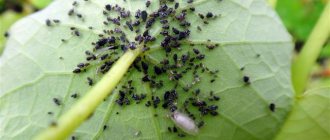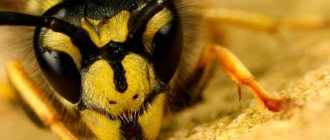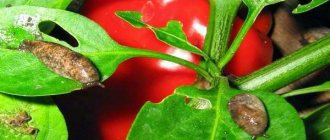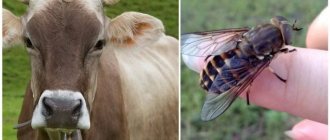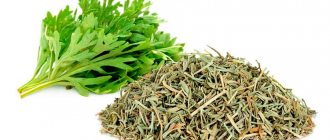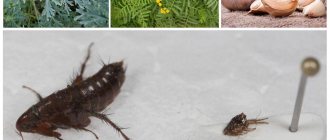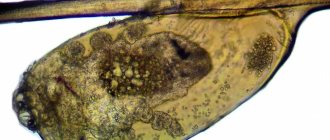Aphids are a pest that affects many garden crops, including pepper. The plant attracts the parasite with the sap on which it feeds. The pest can appear not only on adult peppers, but also on seedlings. This is especially dangerous because all crops can die in a short time. But how to deal with pests at home? First you need to find out the reasons for the appearance.
Causes of the problem:
- increased air temperature in the room where the crop is located, especially at night;
- too frequent irrigation or high air humidity, which leads to the accumulation of a large amount of liquid near the root system;
- use of poor-quality land that has undergone poor cultivation;
- planting materials were contaminated.
Another reason is the penetration of the parasite into the crop through an open window. For whatever reason it gets onto the crop, it is important to detect and destroy it in a timely manner.
Types of aphids that parasitize peppers
There are many types of aphids. The following pests are considered the most dangerous for pepper seedlings grown on a windowsill or in a greenhouse.
Potato aphid
The length of wingless adult individuals, colored in white-green and reddish-brown tones, reaches 2-3 mm. Potato aphids pierce the leaf blades of peppers and release toxic substances that cause deformation of the tops of home seedlings.
Lumps and curls appear on damaged foliage. Affected leaves turn yellow and fall off.
Cotton (melon) aphid
The body outline of the pests is pear-shaped. The length of insects reaches 2 mm. The matte body can be painted in various shades of yellow-green. Against the background of damage to the underside of the foliage, the green mass turns yellow, curls and dries out.
The pest population is rapidly increasing. Weakened seedlings soon die. In the area of sugary secretions of aphids, sooty fungi develop, which impede the process of photosynthesis.
Peach greenhouse aphid
The wings of the peach greenhouse pest are transparent, and the head is black and shiny. On the greenish abdomen you can see bright black areas.
Winged individuals are capable of transmitting viral infections to crops from external sources. The affected leaf blades, covered from below with sticky secretions of aphids, begin to curl. The leaves turn yellow and fall off. Insects are capable of transmitting tobacco mosaic virus.
Potato aphid
Signs of an aphid infestation
I recognize the appearance of aphids in a greenhouse with peppers by characteristic signs:
- Dehydrated, dried, darkened, curled leaves.
- Deformed stems and buds.
- Suppression of development, stunted growth.
- Withered flower stalks.
- A sticky, dried layer on the surface of the leaves.
Aphids usually hide on the underside, hidden side of the leaf. Therefore, I am not lazy to turn over each leaf in order to detect the pest in time.
aphids in the garden
Causes of the pest
Why does such an unpleasant attack occur? There are many reasons why there may be an invasion of aphids on pepper seedlings growing indoors. Most often the problem occurs in the background:
- Incorrect temperature conditions, too warm air in the room at night.
- Increased humidity of the root system.
- Using contaminated seed material or insufficiently treated soil for planting.
- Entry of adult insects through an open window or doorway of the greenhouse.
Pepper seedlings are most often grown indoors, on window sills, in a greenhouse or outdoors. Under these conditions, aphid infestations are observed due to the use of contaminated soil or seeds.
Important! To prevent the occurrence of such a problem, it is necessary to carefully select seed material for planting, as well as use high-quality soil.
melon aphid
Prevention of aphids
It is easier to prevent aphids from appearing than to deal with the existing problem later. There are several preventative measures that will help avoid the occurrence of the pest:
- Before planting peppers, disinfect the soil - for this you can use a solution of potassium permanganate, put the soil in the freezer for a while, or vice versa, thoroughly warm the soil, etc.;
- treat pepper seeds with a special substance before planting;
- Wash seedling containers thoroughly;
- do not place the plant in a room with indoor flowers;
- Fertilize the crop regularly, since a healthy bush can better resist parasites and pathologies;
- treat the pepper with any preparation that prevents the appearance of aphids.
Find out when to plant pepper seedlings in the Urals here.
How to recognize aphids on peppers
It is quite difficult to detect aphids on seedlings. Insects carefully hide, which makes it impossible to notice them with the naked eye. Only when the population increases too much can aphids be seen on the foliage.
However, detecting a problem at this stage often does not allow the seedlings to be saved. The leaf blades of an infected crop are often severely damaged.
The damage to pepper seedlings by aphids is indicated by:
- causeless drying of leaf plates;
- the appearance of a thick, sticky and shiny substance in the area of the trunk and foliage;
- the presence of larvae and small crawling pests on the back side of the green mass.
When examining pepper seedlings, you need to arm yourself with a magnifying glass and sit close to the plants. Each leaf plate must be carefully folded back and the plants carefully inspected for the presence of aphids.
Advice! If pests are detected on peppers, it is recommended to begin treatment as soon as possible.
Peach greenhouse aphid
How to identify the problem - signs and symptoms of damage to pepper seedlings
Problems can be identified at an early stage by the following signs:
- the seedlings turn yellow, while the leaves curl, dry out and eventually fall off;
- absence of ovaries, and if they form, the buds do not open but quickly fall off;
- the presence of a viscous, sticky liquid on the culture;
- At the bottom of the pepper, the naked eye can detect parasite larvae and egg laying;
- deformation of young shoots, which leads to a stop in the development and growth of the bush.
It is important to identify aphids promptly. This will help you take appropriate measures and save the pepper seedlings. Ignoring the parasite leads to the death of all bushes and the spread of the pest to other crops.
How to get rid of a pest
In cases of mass invasion of aphids, it is necessary to treat the seedlings with chemicals. Below you can find the most effective drugs that will help you quickly deal with pests.
Aphids have appeared on peppers - how to treat them? Agronomists most often use the drugs described below to control aphids on pepper seedlings.
Agravertine
Agravertin is an insectoacaricidal drug with contact-intestinal action. The main components of the chemical paralyze adult aphids and their larvae. The effect of the drug can last for 14-20 days.
The main component of Agravertine is the natural neurotoxin Avertin, which is not addictive to pests. The active components remain in the soil for only a couple of days, after which they break down into safe components.
Agravertine goes on sale in ampoules with a capacity of 5 and 10 ml. The contents of the ampoule are mixed with 1 liter of water. After this, the solution must be thoroughly mixed and the seedlings treated. It is recommended to use a fine spray for spraying.
Important! Treatment can be carried out only on those days when the air temperature is not lower than 18-20 °C.
Intavir
A broad-spectrum chemical helps to effectively combat homoptera, coleoptera, lepidoptera and other pests. Intavir has intestinal and contact effects. The presence of cypermethrin in the composition allows you to paralyze all organs of insects and have a destructive effect on their nervous system.
What varieties can be found on the vegetable?
Today, on average, five main types are known: nightshade, greenhouse, peach, green and black aphids. It should be noted that the last two insects are considered the most dangerous: they not only parasitize the plant and feed on its vital juices, but also produce a substance that is a nutrient medium for fungi.
Green
Green aphids settle in large colonies on young pepper seedlings. A distinctive feature of this species is its love for flowering shoots. That is, by the end of spring, insects climb onto the stems and leaves of the plant, but aphids begin their violent reproduction closer to the budding and fruiting phase. Until this time, it is difficult to notice them, since the main group of insects hides at the place where the leaf attaches to the stem.
Black
The black aphid, also known as the house aphid, is the smallest insect and a member of the family. Small, no more than 0.3 mm in size. It is common for black aphids to live on the stem and inside of young pepper leaves. Nutrition mainly comes from the nutritious juices of the plant, and the most important elements in the aphid diet are carbohydrates and proteins, broken down into amino acids.
Therefore, it is not at all surprising to notice this parasite on young shoots. In addition, during digestion, aphids secrete honeydew, which tastes sweet and attracts ants. Most often, these two types of insects work together, therefore, where aphids appear, ants will soon appear, and vice versa.
Peach
A small, oval-shaped insect. Larger than black aphids: size ranges from 1 to 2 mm. Like other species of this family, the peach aphid appears, reproduces and lays eggs on the inside of the pepper leaf, but differs in appearance - the insect’s body covers are colored in red and orange tones.
Greenhouse
The third largest aphid, its body length is from 2 to 3 mm. Externally, the insect more closely resembles the green variety, but the size characteristic turns out to be the decisive difference. The main feature of the greenhouse specimen is that it is extremely thermophilic. The favorite “nesting” place for this parasite is greenhouses, therefore, it will not spread to cultivated plants outside the greenhouse.
Nightshade
The largest insect of the entire family: average size 4 mm. The body of the nightshade aphid is covered with light green chitin, however, this pest is unlikely to differ from other species in its behavior.
What are the dangers of treating pepper seedlings with chemicals?
Treating pepper seedlings with chemicals is considered one of the most effective ways to control aphids. However, if you prepare the solution incorrectly, you can cause burns on the foliage. In this case, tiny plants may die. It is also worth considering the toxicity of chemicals, which can cause an allergic reaction in the gardener or poisoning.
Note! In order to destroy pests found on seedlings, it is better to use biological products or folk remedies that do not contain harmful substances.
Biological products
If aphids appear on pepper seedlings, do not worry. You can spray young bushes. Before you begin processing, you need to select a product. The most effective biological products are those listed below.
Aktofit
The insecticide allows you to quickly destroy various insects that eat young plants. The liquid has a specific odor and is colored yellow.
Actofit is not addictive, which is considered a significant advantage. To prepare the solution, thoroughly mix the contents of the bottle with water.
Important! It is necessary to follow the manufacturer's recommended dosage of the biological product.
Fitoverm
Fitoverm has an intestinal contact effect. After spraying the seedlings, the active components of the biological product penetrate the body of the pests, provoking the development of paralysis and further death. The rapid destruction of Fitoverm components in water and soil is considered a significant advantage.
The manufacturer does not recommend mixing the biological product with other agents. To prepare the solution, you will need to dilute 10 ml of the contents of the bottle in 1 liter of water. Processing of seedlings is carried out in 2 stages. Repeated spraying is carried out 10 days after the first treatment.
Akarin
Akarin is considered a biological insectoacaricide with contact-intestinal action. After treating young pepper bushes growing at home, the insects’ ability to digest and absorb nutrients is blocked.
5 hours after spraying, the aphids are paralyzed and soon die.
To prepare the solution, you will need to dilute 8 ml of solution in 1000 ml of water.
Fitoverm is a popular remedy for aphids
Folk methods of struggle
How to treat aphids on pepper seedlings? Below you can find the most popular folk remedies that will help destroy pests.
Laundry soap
Using laundry soap, you can prepare a solution that can be used to treat the affected pepper bushes. To do this you will need:
- Grind a third of the laundry soap on a fine grater.
- The resulting shavings must be transferred to a deep container and filled with 1000 ml of water.
- 30-35 g of vegetable oil is poured into the mixture. After thoroughly mixing the components, the solution should be infused for 100-120 minutes.
- After the specified period of time, you can strain the tincture and spray the affected green mass.
Important! Plants are treated daily for 4 days.
Ash
Having found aphids on peppers, you can spray the seedlings with an ash solution, to prepare which you will need to combine a couple of glasses of ash with 10 liters of water. 150 ml of soap solution is added to the liquid. Processing of young peppers should be carried out immediately after preparing the mixture.
Biological methods
Some insects eat aphids
When insects have just appeared, biological control methods will help. Birds and insects that will kill aphids:
- sparrows;
- tits;
- ladybugs;
- wasps.
The hoverfly also eats aphids. Care must be taken to ensure that birds and insects do not harm other plants in the greenhouse.
They are lured into the greenhouse with food and drink.
How to get rid of aphids in a greenhouse
If such a misfortune as the defeat of seedlings by aphids occurs in a greenhouse, do not be upset. You can use biological products that will help cope with pests and not harm fruiting.
Treatments will have to be carried out over 4-7 days, depending on the number of insects. However, as a reward for his efforts, the gardener will receive a good, and most importantly, environmentally friendly pepper harvest.
When growing peppers, it is important to systematically ventilate the room in which the pots with seedlings are located.
What is an insect
Aphids are small insects with six legs, whose dimensions do not exceed 4 mm. It is characterized by a high rate of spread. On the head there is a small proboscis, with the help of which the insect pierces leaves or stems and feeds on nectar.
There are two types of aphids - winged and wingless. In the first case, the parasite has the ability to move from plant to plant through the air.
Aphids are also distinguished by color. Depending on the color, the following types are distinguished:
- Green. It is a pest with an oval translucent body and brown antennae. The length of the body is on average 0.5 mm.
- Black. This is an indoor pest. Typically the parasite grows to 0.3 mm.
Adults reproduce as follows:
- the pest lays eggs - their number in one clutch can reach 150 pieces;
- the masonry waits out the winter;
- the larvae hatch with the onset of warm weather;
- It takes them seven days to mature and after a week they become adults;
- the adult insect begins to reproduce asexually;
- the aphid takes wings and moves to other bushes;
- During the autumn months, insects reproduce sexually.
Find out about poor growth of pepper seedlings here.
Reproduction occurs best at a temperature of 25-30 °C. When it drops below 20 °C, the speed decreases by 2 times. In addition, the process of maturation of adults increases.
Preventive measures
It is much easier to prevent the appearance of aphids on peppers than to get rid of this scourge. Experts recommend for preventive purposes:
- Carefully inspect seedlings purchased at the market to ensure they are not affected by pests.
- When growing seedlings, it is necessary to systematically inspect the lower parts of the foliage in order to promptly detect pests and take measures to eliminate them. You can use a magnifying glass to make sure you don't miss the affected areas.
- Along the rows of pepper seedlings, it is necessary to plant onions and garlic, the aroma of which repels insects.
- In the room where young pepper bushes grow, it is recommended to maintain an optimal humidity level and temperature within 20 degrees.
The spread of aphids on pepper seedlings can cause the death of bushes or a decrease in yield. It is very important to promptly identify pests and take measures to combat them. There are many drugs that can be used to kill aphids. If desired, you should use folk remedies. The methods proposed in the article to combat aphids on pepper seedlings will help every gardener choose the most suitable option for himself.
Where and why does it appear?
Aphids overwinter in the ground or in last year's autumn leaves. If aphids damaged peppers last gardening season, you should not plant them in the same place this year, as there is a high risk of infecting new plants. Insect eggs overwinter in leaves or under tree bark.
As the weather gets warmer, females are born first, which will then give rise to a whole colony of aphids. Ants play a major role in the appearance of aphids. Since not all aphids have wings to move, ants help them. In return they receive food - honeydew.
Important! This symbiosis allows some to be constantly full, while others expand their habitat.
The main reason for the appearance of aphids on pepper seedlings is that young shoots are very attractive to pests, they are juicy and rich in nutritional components.
Causes of plant damage
In winter, the eggs lie under leaves or in the bark of trees. The larvae hatch three times during the summer season: in spring, early summer, and warm autumn. Aphids appear on home or greenhouse seedlings if:
- the soil and (or) seeds were not treated before sowing;
- seedlings are often watered, moisture accumulates around the roots;
- seedlings grow in a hot, damp room;
- night temperature is increased;
- an adult insect fell into the window with a flow of air.
In open ground, the spread of the parasite is facilitated by ants feeding on its sugary secretions.
Additional Information! During the winter, ants transfer pest eggs to anthills to protect the colony from destruction.
Signs of aphids
The main symptoms of seedling damage:
- suddenly, without objective reasons, the leaves dry up;
- the tops are deformed;
- a whitish sticky coating forms on the trunk and plates;
- curling, wilting of leaves;
- Small bugs crawl on the back of the leaves.
In open ground, in a greenhouse, the inflorescences of grown bushes dry out and fall off; Ants crawl in the root area and along the shoots.
Common mistakes
Aphids on pepper seedlings most often appear due to mistakes by the summer resident himself. Here are some of them:
- Very high temperature in the room, which is favorable for the proliferation of parasites;
- Excessive watering;
- The soil was not tilled and the seeds were not treated;
- Failure to comply with the concentration of the active substance;
- Negligent attitude to the problem.
Reviews
Elena
I have aphids on my Belozerka pepper. I saw it too late and treated it with soapy water, but it didn’t help. They recommended Fitoverm, this is a very good remedy. The aphids have all disappeared. My neighbor also told me that she buries onion peels into the soil in the spring and aphids do not appear. I’ll probably try it too, it’s still better than poisoning plants with pesticides.
Rose, Moscow region
The soap may be good, but I didn’t see any effect from it. Perhaps modern pests are already accustomed to such poison for them and have adapted. In the store, the saleswoman showed me a whole bunch of different products, I chose Fury, and used it according to the instructions. I had aphids on peppers and bushes. I brought everything out. I was afraid that these parasites would plague me again in the new season, but surprisingly, there were no aphids. Although now I know how to remove this nasty thing right away.
Nikolai
I had a sea of aphids, peppers grew in a greenhouse. Last year we sprayed tobacco and all the aphids came in. This summer, as soon as we saw it, we immediately added tobacco infusion and treated it. There was zero result, but there seemed to be even more insects. At the city indoor market, the garden department recommended Aktar, in powder. I diluted it in water, sprayed the peppers and grabbed some eggplants; I also noticed aphids on them on a couple of bushes. After treatment, all the aphids immediately fell off the bushes, and that’s it, they disappeared. This, I understand, is the effect.
General tips and tricks
Since the greenhouse is an enclosed space, it is important to follow the following rules for aphid treatment:
Always use a respirator, goggles, and clothing that covers your body. Sprayed particles should not come into contact with human mucous membranes and skin.- Do not use chemicals that have expired. They can accumulate toxic substances that will be dangerous to the health of not only the owner of the greenhouse, but also those people who will consume the peppers.
- Read the instructions carefully and follow the dosages recommended by the manufacturer. An overabundance of insecticides is dangerous.
- Never mix chemical and biological agents to improve effectiveness.
- Be sure to cultivate the soil around the pepper, since the larvae can remain viable for a long time while in the soil.
- After all work has been completed, you need to ventilate the greenhouse.
The frequency of spraying is important. There is no need to think that a one-time treatment will protect the pepper for the entire fruiting period. The manufacturer indicates on the packaging exactly what period can be considered active and how often it is recommended to spray pepper with this product.
Do not rush to buy insecticides and do not use them as a preventive measure more than 1-2 times per season. Along with their benefits, they can also be dangerous to health, especially if the greenhouse feeds a family with small children. The means at hand are no less effective, but they are absolutely safe for health.
Fighting aphids
The aphids are quite small and blend in color with the plant. Insect eggs are most often located on the inside of leaves. Therefore, sometimes it is not immediately possible to determine the presence of a threat to plantings.
However, you can detect symptoms indicating that a plant is infested with aphids:
- Drying and curling leaves;
- Sticky spots on leaves;
- Whitish eggs and an adult colony of aphids on the underside of leaves.
How to spray peppers against aphids? There may be three options here:
- Biological drugs;
- Chemicals;
- Folk remedies.
